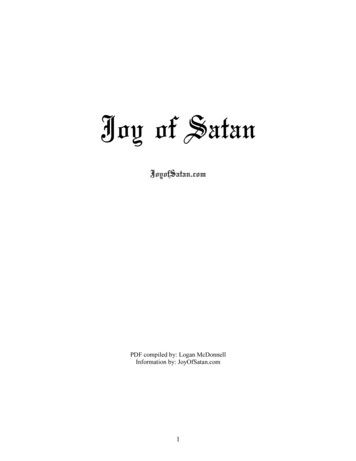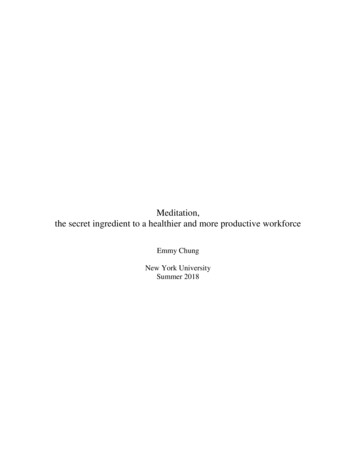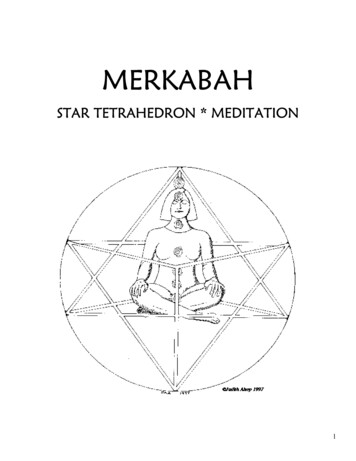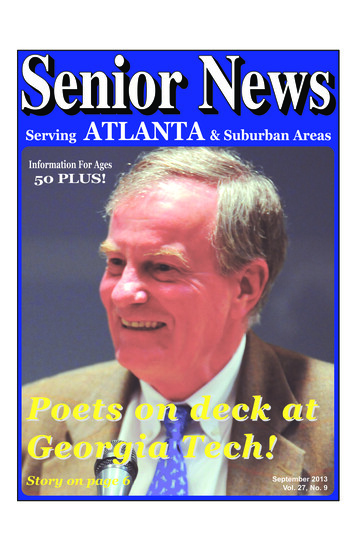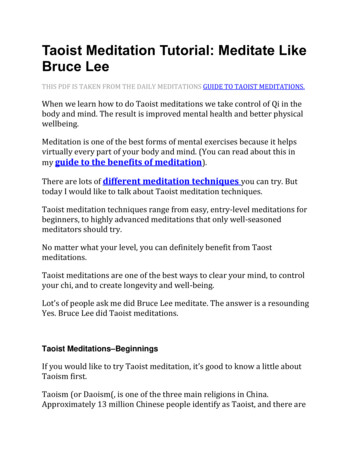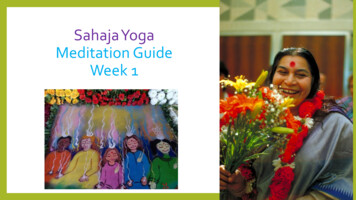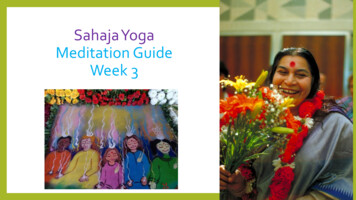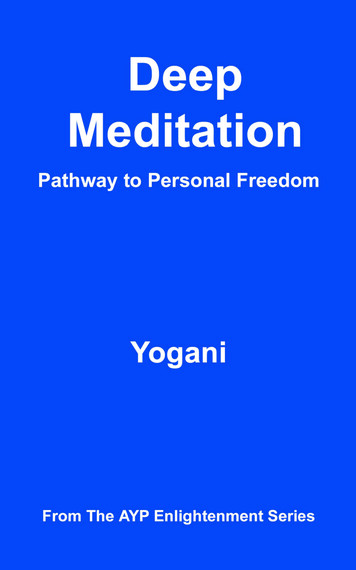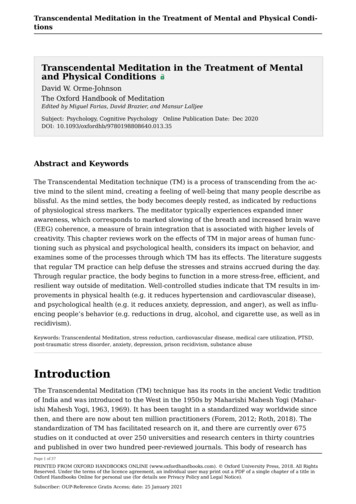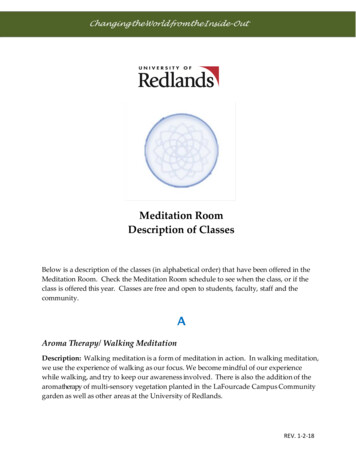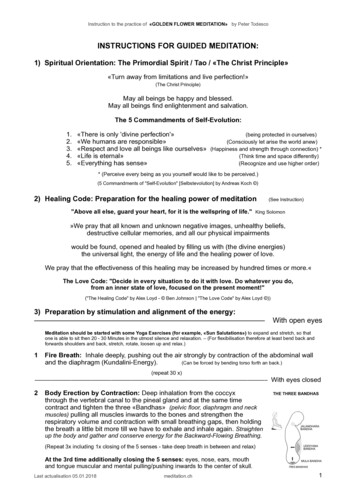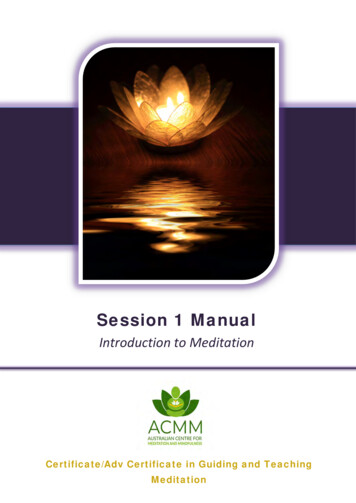
Transcription
Session 1 ManualIntroduction to MeditationCertificate/Adv Certificate in Guiding and TeachingMeditation
Session 1 Introduction to Meditation and Relaxation2Contents Session 1Meditation and Mindfulness3Meditation Traditions8The history of meditation and mindfulness12Why people meditate21The motivation to meditate24Meditation Hints31Attitudes to bring to your meditation and study33Stress and the Relaxation Response40Stress and You44The Holistic Meditation Model49How to achieve the Relaxation Response whenguiding meditation51The foundation of meditation: Grounding57Recommended Reading67Further Resources68References69Session 1 RESPONSE SHEET (Please download and save to your computer.You will fill in your responses here and send your response sheet to your coach oncecompleted). We suggest you read through the whole session first and plan yourtime according to the kinds of activities allocated for this session. 2020 Lisa Forde & Australian Centre for Meditation and Mindfulness
Session 1 Introduction to Meditation and Relaxation3MeditationThe word meditation, medicine and medication all share the same Latin root;medicus meaning “to cure” and originally “to measure”. Both medication andmeditation seek to restore measured balance to life or to dis-ease, but in vastlydifferent ways.Meditation is an ancient tradition in many different cultures, from Western Europeto the East; it plays a part in aboriginalcultures on all continents and has held aplace in civilisation throughout history.There are many definitions of meditation,since experiences of meditation and itseffects are so subjective and can varygreatly depending on the person’smakeup.Here are some possible definitions: The act of inward contemplation inthe broadest sense and moretechnically, the intermediate statebetween mere attention to anobject (dharana) and completeabsorption in it – Samadhi. 1 A generic term used to refer to a wide range of practices for self-regulationof emotion and attention 2 In its simplest and most general sense meditation is a mental disciplineinvolving attention regulation. More specifically, the broad act of meditationcan be sub-classified according to the processes it involves or the outcome itleads to. (This definition was developed by Meditation Australia and theGawler foundation.) A naturally occurring rest state; it is resting in yourself while remaining awakeand alert. Meditation is innate, and your body already knows how to do it.The human body has an instinctive ability to shift into profound rest states inorder to heal, energize, integrate, tune itself up and assimilate learning. 3Taylor 1997Gunaratana 20023 Lorin Roche 199812 2020 Lisa Forde & Australian Centre for Meditation and Mindfulness
Session 1 Introduction to Meditation and Relaxation4And a more detailed definition: “Meditation is used in a generic sense to cover a wide range of mentalactivities, much in the way the word ‘travel’ is used to describe a wide rangeof physical activities. We can say we will travel from one city to another. Butthat says nothing about the detail. Will we travel by car or by plane? Will weget there as quickly as possible or will we meander along the way? Just asthere are many ways to travel, there are many different ways to meditate.Therefore when people say they are ‘meditating’ they could be involved inany one of a wide range of activities.Attention regulation, which is essentially a fancy way of describingconcentration, can be directed to various objects such as the breath or body,a mantra, a thought or prayer, a visualization or mental image, a physicalobject, a sense of being or stillness. These in turn can be used to cultivatevarious outcomes, including therapeutic outcomes, cognitive changes suchas improved concentration, non-attachment to experiences, stillness of mindand an attitude of acceptance. Other outcomes include meditative states ortraits such as undistracted awareness, transcendence of thought, oneness,spiritual insight and enlightenment.Meditation can also be identified by the physical effects it produces, such asphysiological, biochemical, hormonal, immunological or neurologicalchanges. 4Ian Gawler, at a Meditation Australia event in November 2019 gave thiseloquent definition: “Meditation is a process that takes us out of activity andinto the stillness of the ‘still mind’ (as opposed to the active mind). This is aplace that is fundamentally peaceful and clear and its natural expression iscompassion and loving kindness. A place of deep natural balance wherehealing emerges.”The development of academic research has been underpinned by the pioneering andongoing influences of Michael Murphy and Stephen Donovan, and the famouspersonal development centre they established in 1961, the Esalen Institute. Many ofthe pioneers in mind body medicine and meditation in the West were either nurturedat Esalen or passed through it, and Murphy and Donovan themselves have providedtheir own contribution to this field with their work ‘The physical and psychologicaleffects of Meditation.’Murphy and Donovan compiled a comprehensive bibliography of the scientificresearch on meditation published around the world.“The body of research is huge and powerfully attests to meditation’s many benefits inthe prevention, management and treatment of a wide range of physical and4Gawler, Bedson 2010 2020 Lisa Forde & Australian Centre for Meditation and Mindfulness
Session 1 Introduction to Meditation and Relaxation5psychological conditions. This evidence base is arguably more extensive than thatrelating to many well-accepted treatments carried out daily in medical practises aroundthe world” 5The Institute of Noetic Sciences https://noetic.org/ compiled a bibliography of allpublished research on meditation. This was maintained for many years, from 1997 to2013. The IONS Meditation Bibliography has now been retired and as suggested byIONS please use scholarly search engines such as Google Scholar. These easy to usesearch engines are updated in real-time and we suggest these search terms:"meditation" or "meditative" or "mindfulness" "There are many meditation techniques and hundreds of versions of the one technique.All techniques, however, fall into one of two categories: concentrative or attentive. Aconcentrative technique (or focussed attention) brings your focus to a single point, soit requires you to focus or concentrate on an image, a word, your breath, or whateverpoint of focus you have chosen. The act of focus and concentration may make it soundlaborious, but the act is done in a spirit of gentleness and light-heartedness, with asense of relaxation and a natural settling into the experience.An attentive technique (open mind) leaves you open to noticing sounds, sensations,feelings, thoughts and anything else that arises during the meditation time andembracing these within your meditation. Again, this is done with a spirit of lightheartedness and the added sense of openness and compassion to whatever arises; it’sok that it is here.Another angle that can be useful for describing approaches to meditation is theintention for the meditation. As a teacher or as the meditator yourself, what do youneed most right now? What is going to be the most beneficial for you or your group?With these questions in mind you can develop a meditation with a clear intent.Meditation can be further categorised by this intent.The intention of Relaxation; to settle and calm the mind, body and heart, resulting invast and varied benefits. The reasons for choosing Relaxation meditation could be inorder to support stress related illness, insomnia, fatigue, a need for nurturing,navigating grief, supporting trauma, recuperating from surgery or illness, physicaldiscomfort and much more.The intention of Awakening/Insight; a process to arrive at more clarity of mind, tocultivate an openness to what is unfolding in each and every moment, a respectfulawareness mindfulness. This process is undertaken with the intention of living a moreawake and aware life, to alleviate the suffering of delusion, to see the joy and5Ibid. p 13 2020 Lisa Forde & Australian Centre for Meditation and Mindfulness
Session 1 Introduction to Meditation and Relaxation6possibilities in each and every moment and much more.Mindfulness style meditation to: You might choose asupport the training of your mind,open your awareness to the infinite possibilities in each and every moment,gain a deeper understanding of the workings and patterns of your mind,reduce stress, cultivate compassion,feel more resilient and better able to adapt,regulate your emotions, feel more present and connected and more.In this course, we will be teaching you both-families of techniques, Relaxation andMindfulness, attentive and concentrative. Often in guided meditations, both families oftechniques are used. They are integral parts of a whole picture that makes up asupport system for an individual.Even with the intention of relaxation, a relaxation meditation can take you on ajourney of self-discovery to a moment of connection and understanding andawakening to living more mindfully. There is a lot of overlap and categorisation cansometimes feel slippery, whilst at other times useful and clear.Think of the analogy of training the mind as like going to the gym to train yourphysical body. Different exercises work on different areas of the body, not unlikedifferent meditation and mindfulness techniques support and work on differentaspects of you, within you. Certain practices/training might work on strengthening,building resilience, emotional regulation whilst others work on cultivatingcompassion, self-awareness and so on.What is the difference between Meditation and Mindfulness?Meditation is an act of formal practice (using focussed attention/concentrative,open monitoring/attentive techniques, or a combination of both) for a set time,(sitting/standing/lying/moving) using a technique from any tradition (includingMindfulness which has its origins in the Buddhist Tradition). The aim of Meditationcan vary from relaxation to clear insight, through to spiritual awakening.Mindfulness practice offers a range of techniques for formal practice with a leaningtowards open monitoring/attentive techniques and has the added dimension ofinformal practice; present mindful awareness in any given moment throughout theday.Although Mindfulness has its origins in the Buddhist tradition, modern Mindfulnesswith its informal practices and growing scientific evidence base has more of a 2020 Lisa Forde & Australian Centre for Meditation and Mindfulness
Session 1 Introduction to Meditation and Relaxation7secular/non-traditional leaning which makes it attractive to people who might nototherwise engage in meditation.Informal Mindfulness Practice has become very accessible and popular, howevertraditional Mindfulness teaches that both a formal and informal practice arenecessary in order to enjoy the full benefits of any set of practices. Formal practicehelps us to develop concentration through the regulation of our attention. When wehave a strong formal practice, then mind rumination tends to lessen, and it could beargued that as a consequence, present moment awareness (or informal practice)happens spontaneously and more readily.As you progress through the course trying the various techniques, you will begin tosee how your own uniqueness and personality influences the way you guide andteach. You will develop your own style using the framework set out in this sessionand throughout the course and adapt and create meditations suitable to you and/oryour teaching.Throughout the course you will be supported to live a more present and awake lifewith many ways to bring mindfulness into action (applying skills, processes,techniques in your daily life), and to then with an intimate understanding of these beable to share what you are learning through your meditation teaching and those youtouch. 2020 Lisa Forde & Australian Centre for Meditation and Mindfulness
Session 1 Introduction to Meditation and Relaxation8Meditation TraditionsWhen we refer to “meditation” we are using an umbrella term that is culturallydependent and somewhat vague, referring generally to the act of entering a deeperstate of consciousness. However, we really need to define which type of meditationwe are referring to, since there are thousands of meditation techniques and thesecan vary greatly in how they are used and the effect experienced. Only the bestknown traditions are listed here. “Probably every culture on earth has producedsome sort of mental practice that could be termed meditation. It all depends onhow loose a definition you give to that word.” 6Perhaps the most widely known and used forms come from the Judeo-Christiantradition. Prayer is a direct address to a spiritual entity 7 and comes most commonlyin the form of recited or repeated verse, as in the Catholic Rosary. Contemplation isa prolonged period of conscious thought about a specific topic, usually a religiousideal or scriptural passage. 8 Both of these are clearly concentrative or focussedattention techniques and they produce deep calm, the relaxation response and asense of peace.Breath awareness and Body Scan techniques are the basis of the MindfulnessBased Stress Reduction Programme (MBSR) developed by Jon Kabat-Zinn in 1979. 9The MBSR programme has become widely used in the medical profession and hasbeen well researched in terms of its effectiveness. These techniques are bothsimple and easy to learn. They are a form of Health Meditation developed from theVipassana tradition which and can be learnt in 8 weeks, (though the practicedeepens over time).Vedic Meditation is the oldest form of yoga and arises from the Hindu tradition. It isbased on concentration. One begins by focusing attention on a simple object suchas a candle flame, point of light, sound (such as OM) or image and moves ontomore complex foci such as chants, religious images, mantras, Japa Mala, chakrapoints and energy channels. Included in the Vedic tradition is Classical YogaMeditation. This really refers to a range of meditations taught within the Yogatradition. “Yoga divides the practice into rules of conduct (yamas and niyamas),physical postures (asanas), breathing exercises (pranayama), and contemplativepractices of meditation (pratyahara, dharana, dhyana, samadhi). The Yoga traditionis the oldest meditation tradition on earth, and also the one with the widest varietyGunaratana 2011ibid8 Ibid.9 on-decoded67 2020 Lisa Forde & Australian Centre for Meditation and Mindfulness
Session 1 Introduction to Meditation and Relaxation9of practices.” 10 Kundalini yoga comes under this heading. The aim of kundalinimeditation is to release and open the “kundalini energy” that lies dormant at thebase of the spine. “Those practicing Kundalini Meditation are known to experiencedrastic changes in the functioning of their body, nervous system, and physiology asthe “kundalini” energy rises from the spine.” 11 This type of meditation uses mantras,breathing techniques, mudras (hand positions) and focussed concentration. 12The Buddhist tradition is 2,500 years old13 and is both concentrative and attentive.Buddhist meditation is categorised into Samatha (calming): involving the cultivatingof a calm and tranquil mind and body, and Vipassana (insight): a way to seedeeply. Vipassana cultivates a clear mind that can open to insight. Both aspectsare contained within the other. Cultivating a Vipassana practice; seeing deeply andgaining insight can be relaxing as, for example, when we feel the relief andrelaxation of understanding the true nature of a situation. We feel a lettinggo. Equally Samatha can be insightful. As we become relaxed, calm and still,insight can arise naturally and spontaneously, without the need to strive for it.Zen Buddhism is known for its movement away from the more formal doctrines,scriptures and rituals of other Buddhist traditions. Teachings in this tradition areimparted from Master to Student and are mostly practice oriented. BreathingPractices and the chanting of Buddhist Sutras are commonly used. Zen meditationis known as Zazen or seated meditation in Japanese; the simple act of sitting in anupright position, with good posture and paying attention to breathing abdominally.14It has its origin in Chinese Zen Buddhism, Taoism and the Mahayana Buddhistschool, and which dates back to the 6th Century. The simplicity of the techniques,belies the challenging nature of mastery. Another Zen approach characteristic of theRinzai School in Japan and Korea is the contemplation of an unsolvable riddle as ameans to transcending into effortless presence.Tantric Buddhism involves the concentrative technique of visualization on specificTantric religious images or Deities. The goal of Tantric Buddhist Meditation is thedissolving of the ego and everyday identifiers related to the ego and thedevelopment of a new identification with the Deity themselves, so that the falsestructures of the ego can be seen and disrobed; leaving the meditator in pureawareness.Vipassana is the oldest of the Buddhist meditation practices. “Vipassana” is a Paliword that means “insight” or “clear seeing”. It comes from the Satipatthana Sutta, ion-extensive-list-of-techniques/12 on-decoded13 Gunaratana 201514 -how-do-you-practice-it/1011 2020 Lisa Forde & Australian Centre for Meditation and Mindfulness
Session 1 Introduction to Meditation and Relaxation10discourse said to come from the Buddha. These formal meditations are designed totrain the mind to become more and more aware of the experience of life withoutgetting caught up in the trappings of unconscious thought, action and existence.The goal is to see the truths of impermanence, unsatisfactoriness and selflessness- 15also known as “insight meditation”. Mindfulness has developed as the moderncounterpart of Vipassana meditation, however it is important to note that Vipassanameditation can differ from other (cultivating) mindfulness style meditations. Theword mindfulness is only approximately 120 years old, an interesting understandingto have as it describes something that is beyond words and deeper than thewestern definition. The modern mindfulness practices focus on mindful breathingand body awareness (heavily influenced by Jon Kabat-Zinn and the MBSRprogramme), metta (loving kindness) practice and a strong emphasis on Mindfullifestyle practices such as living with greater awareness, compassion, non-judgmentand detachment from the pull of emotions. Mindful practices seek to observe andwatch, and respond with clarity and calm, rather than react. Walking meditation isknown to have emerged from this tradition.A more detailed discussion of mindfulness history and techniques can be found inSession 3 and in the Mindfulness and Buddhist Psychology and BringingMindfulness Home electives.Transcendental Meditation (TM) is a kind of Mantra meditation introduced by theMaharishi Mahesh Yogi in 1955 and originates in India. 16 In order to learn TM onemust be trained by a licensed practitioner who mentors the student through thelearning process. Although widely popular in the 60’s and 70’s, the TM movementhas been criticised for cultish practices and the quality of its prolific body ofscientific research as to the effectiveness of TM. It was made famous by celebritypractitioners such as the Beatles, Katy Perry and Russell Brand. 17Taoist meditation. Taoism is derived from Lao Tzu in China. The goal of thispractice is to live in harmony with “Tao” or nature. The reading of the Tao Te Ching(a classic Chinese Taoist text dating from at least the fourth century BC) is central tothe philosophy of Taoism. The meditation techniques used include: concentration,mindfulness, contemplation, as well as various forms of visualization. 18 Wayne Dyer’sbook Living the Wisdom of the Tao is a beautiful guide to understanding,integrating and exploring the ideology of the Tao from a Western perspective.There is a variety of moving meditations that also have deep and ancient roots. QuiGong and Tai Chi are forms of moving meditation and seek to harmonize and on/17 on-decoded18 editation-extensive-list-of-techniques/1516 2020 Lisa Forde & Australian Centre for Meditation and Mindfulness
Session 1 Introduction to Meditation and Relaxation11the breath, body and mind. Qi Gong has been incorporated by Buddhism,Confucianism and Taoism and seeks to balance “qi” energy, or vital life forceenergy. Both these forms of moving meditation are done with slow, mindfulmovements and specific breathing practices to bring about a calm, relaxed state ofawareness. Tai Chi is an ancient Chinese tradition used to alleviate stress. It hasbeen used for general fitness since the 16th century.There are also more creative forms of meditation such as Visualization and GuidedImagery. Guided meditation can incorporate techniques from almost any traditioninto a guided experience to follow. This is ideal for modern meditators who need tofit meditation into a busy life. It allows them to access the benefits of the practicemore readily and allows teachers to work with a greater number of students byreplicating their guided meditations on easily accessible audio or video files whichcan then be accessed on cd, online or on apps. Guided Meditation can utiliseVisualization as a tool for relaxation and insight. Guided Visualization can utilize thesenses, body awareness and the emotions to create a powerful and engagingexperience that can lead the listener into a deep meditation. This can be the easiesttechnique to access for beginners since it is closely guided and highly sensory.Creative moving meditation or meditative arts can involve intuitive drawing,dancing and sculpting. These art forms when practiced mindfully comprise aconcentrative technique practised by Chinese calligraphers, Indian Mandala makers,Tibetan sculptors and artists, Zen poetsand Whirling Sufi dancers. 19 Eachexpresses a spiritual tradition throughtheir art form.Meditative arts can bring deep expressionand emotional resolution and clarity, aswell as some of the benefits of othermoving meditations such as connection tolife force energy and deep creativity.Once again it is easier than other forms ofmeditation as the activity is engaging andenjoyable. These meditation forms havean important place in the map of meditation techniques. They are very useful as anintroductory technique and suitable for those unable to reach stillness due totrauma, depression or physical inability. They can also be excellent for movingstagnant emotional energy and meditating when we are unwell or in /what-is-meditative-art 2020 Lisa Forde & Australian Centre for Meditation and Mindfulness
Session 1 Introduction to Meditation and Relaxation12The history of meditation and mindfulnessAlthough this is an older book, its review of the history of meditation is both conciseand comprehensive.Read the introduction to “The Physical and Psychological Effects of Meditation: AReview of Contemporary Research with a Comprehensive Bibliography, 19311996.” Murphy, Donovan and Taylor. (see link below). Although an older book, itgives a thorough account of the early history of meditation. Then answer thequestions that follow:Introduction to the Physical and Psychological Effects of Meditation: A review ofcontemporary research by Michael Murphy, Steven Donovan and Eugene TaylorSome Definitions:1.1 What are the two countries that hold the original meditative traditions? . . . . . . . . . 1.2 a) Why is it unwise to refer simply to the practise of Buddhism or Hindu ingeneral terms when defining meditation? . . 2020 Lisa Forde & Australian Centre for Meditation and Mindfulness
Session 1 Introduction to Meditation and Relaxation13 1.2 b) What should we include in our definition when identifying a particular type ofmeditation? The Americanisation of Meditation.1.3 a) What was the landmark event that increased Western awareness ofmeditation? 2020 Lisa Forde & Australian Centre for Meditation and Mindfulness
Session 1 Introduction to Meditation and Relaxation14 1.3 b) What happened here for the first time? 1.4) Do some research on the internet and find 3 books written by importantpractitioners and authors Hindu yogi Paramahansa Yogananda and JidduKrishnamurti. (3 books each) 1.5) What were the 3 major cultural events that took place in the 1960’s thatopened an entirely new era of popular interest in meditation. Give a briefdescription of each event. 2020 Lisa Forde & Australian Centre for Meditation and Mindfulness
Session 1 Introduction to Meditation and Relaxation151) 2) 3) 2020 Lisa Forde & Australian Centre for Meditation and Mindfulness
Session 1 Introduction to Meditation and Relaxation16 1.6) What was the belief about meditation in the culture in the 1970’s that allowedmeditation to take its place as an enduring ethic of that generation? TM and the TM-Sidhi Project1.7 a) What kind of meditation has undergone the most prolific research? 1.7 b) What has been described as the Maharishi effect? 2020 Lisa Forde & Australian Centre for Meditation and Mindfulness
Session 1 Introduction to Meditation and Relaxation17 Jon Kabat-Zinn1.8a) What is melatonin and what is thought to be its effect on cancer cells? 1.8 b) What was observed in the melatonin levels of meditators in Kabat-Zinn’s1995 study? 2020 Lisa Forde & Australian Centre for Meditation and Mindfulness
Session 1 Introduction to Meditation and Relaxation18 1.8 c) What does this imply for the relevance of meditation to possible cancertreatment?
The word meditation, medicine and medication all share the same Latin root; medicus meaning "to cure" and originally "to measure". Both medication and meditation seek to restore measured balance to life or to disease, but in vastly - different ways. Meditation is an ancient tradition in many different cultures, from Western Europe
